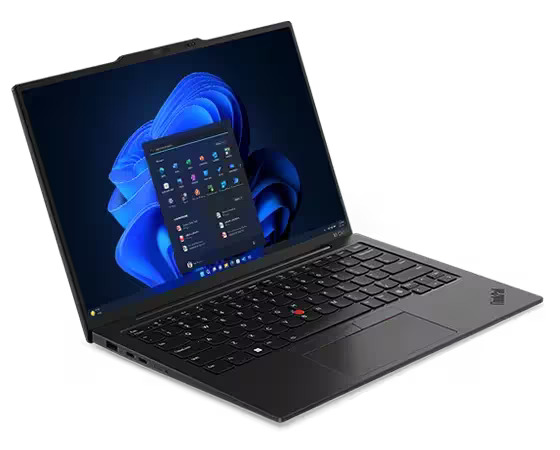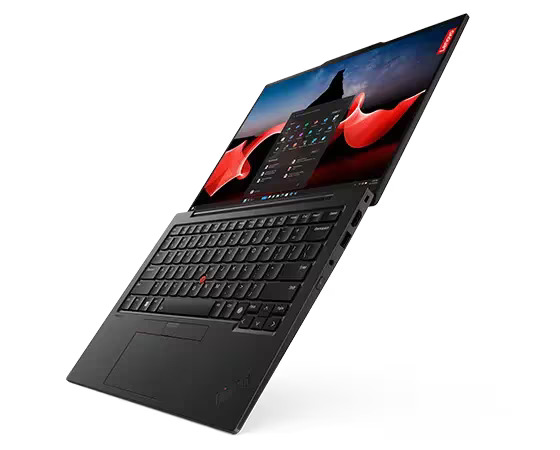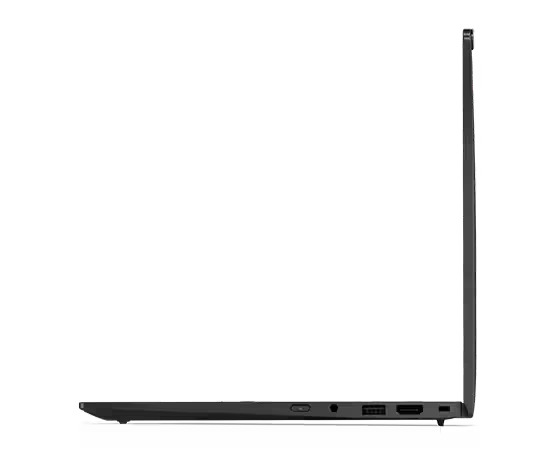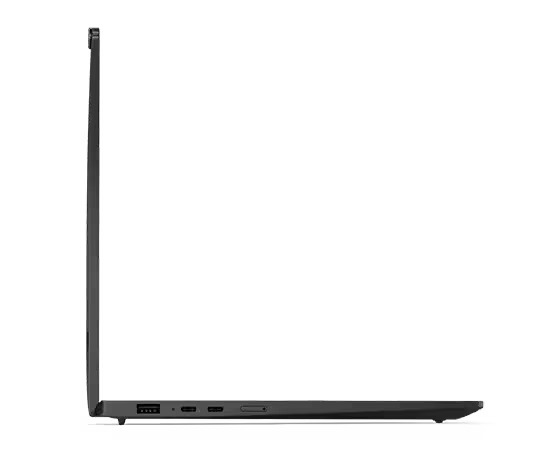The laptop we’re reviewing is the Lenovo ThinkPad X1 Carbon Gen 12, which builds on the success of its predecessor. In the past, we’ve also reviewed the X1 Carbon Gen 7 and X1 Carbon Gen 10, both of which have received great reviews from us. With this latest model, we expect it will perform even better.
The laptop’s main highlights include the new Intel Core Ultra 7 series processors, which deliver powerful processing speeds. In addition, users can enjoy a stunning visual experience through the OLED display. Additionally, the latest LPDDR5x memory, PCIe 4.0 SSDs, and a larger 57Wh battery further boost its performance and battery life. Although the internal components have undergone significant upgrades, the appearance remains the same.
Specifications
| Screen | 14″ 2.8K (2880 x 1800), OLED, Anti-Glare, Anti Reflection, Anti Smudge, Non-Touch, HDR 500, 100% DCI-P3, 400 nits, 120Hz, Low Blue Light, ATNA40YK20-0 |
| Processor | Intel Core Ultra 7 155H (E-cores up to 3.80 GHz, P-cores up to 4.80 GHz) |
| Wireless Connection | Intel Wi-Fi 6E AX211 2×2 AX vPro, Bluetooth 5.1 (Windows 10) or Bluetooth 5.3 (Windows 11) |
| Graphics card | Intel Arc Graphics |
| Memory | 32 GB LPDDR5X-6400MHz (Soldered) |
| Storage | 2 TB SSD M.2 2280 PCIe Gen4, manufactured by Samsung |
| Ports | 2 x USB-A 3.2 Gen 1 (5Gbps) 2 x USB-C Thunderbolt™ 4 (40Gbps) 1x Headphones/mic combo jack 1x HDMI 2.1 (supports resolution up to 4K@60Hz) Optional SIM slot |
| Battery | 57Wh battery with 65W Type-C charger |
| OS | Windows 11 Home |
| Weight | 2.46lb (1.12kg) |
Design
In Lenovo’s other laptop lineup, the company offers a variety of color options. However, for the X1 Carbon lineup, the company still sticks to matte black. Another advantage is that black never goes out of style. The sleek black color (Eclipse Black with Carbon Fiber Weave), combined with the carbon fiber and aluminum alloy materials used throughout the body, contributes to its high-end pricing.

It has the same dimensions and body weight as the previous generation model. The dimensions of this laptop are 312.8 x 214.75 x 14.96 mm, and it weighs 1.12 kg. Its MIL-STD-810H certification ensures durability and enables it to withstand harsh environmental conditions.
The display housing has a solid black skin-friendly coating instead of the woven texture used in its predecessor. The new coating also provides a better feel and is comfortable to handle. However, it retains the iconic ThinkPad X1 branding and Lenovo nameplate, with a familiar glowing red dot on the ThinkPad X1 logo.
There is a small bump in the middle of the top of the display housing that integrates the network antenna. After all, the laptop supports LTE, and these antennas help ensure reliable signal transmission.
Display
As a top-of-the-line business laptop, an OLED display is essential. The model under review features a 14-inch 3A (anti-glare, anti-reflective, and anti-smudge) OLED display with a resolution of 2880 x 1800 and a refresh rate of 120Hz. The display features a 16:10 aspect ratio and a screen-to-body ratio of up to 89%, providing ample screen real estate for productivity. Lenovo claims that the display covers 100% of the DCI-P3 color gamut, has 400 nits of brightness, supports 1.07 billion colors, and is certified for Dolby Vision and HDR True Black 500 to ensure an exceptional viewing experience.

Another important and positive factor we found in this OLED display is its minimal reflections, which are significantly different from other OLED displays. Thanks to the anti-reflective coating on the surface, reflections are effectively eliminated. Additionally, this OLED display features eye protection to ensure a comfortable viewing experience. We did not experience any eye strain during long-term use, which is a common issue with OLED displays.
For testing, we chose the DisplayHDR test app from the Microsoft Store instead of the Spyder X. After completing the test, we found that the screen is Samsung ATNA40YK20-0. The display covers 100% sRGB, 98% Adobe RGB, and 99% DCI-P3 color gamuts, with a peak brightness of 500 nits. It has an average delta E value of 0.71 and a maximum delta E value of 2.09. These results highlight the high quality of this screen, which is suitable for both everyday office tasks and graphic editing.
At the top of the display, there is a bump housing essential components, including the webcam, IR sensors, LED indicators, and network antennas. The webcam hole is equipped with a Full HD sensor. It includes a privacy shutter that allows users to block the camera for privacy when not in use.
Screen Test Results |
|
| sRGB | 100% |
| Adobe RGB | 98% |
| DCI-P3 | 99% |
| Maximum Brightness | 500 nits |
| Average Delta E | 0.71 |
Keyboard
The laptop comes with a spill-resistant keyboard with 1.5mm of key travel and white backlighting. One noticeable change is that the “X1” is missing from the ThinkPad branding on the lower right, but the “ThinkPad X1” branding remains on the display case.

The Ctrl and Fn keys have swapped places, which is a relief for users accustomed to the traditional layout. However, for those who prefer older settings, the BIOS allows customization of the key functions. The second change is the addition of a dedicated fingerprint recognition key to the right of the Ctrl key, which not only improves convenience but also provides faster and more accurate recognition.
Another change is the F8 key, which allows you to change the performance mode, although it lacks a dedicated mode for gaming laptops. These modes can also be adjusted in the battery settings. Finally, it is worth noting the functionality of the red dot key: double-click it will open the shortcut menu to access laptop settings and customization options.
Below the keyboard is a glass trackpad measuring 4.72 inches in width. It’s large enough to allow for seamless navigation with just a swipe across the entire window. Additionally, the trackpad supports TrackPoint functionality, allowing users to navigate like a traditional mouse or double-click to access the TrackPoint shortcut menu. However, it has been observed that the trackpad needs improvement. As a high-end laptop, the ThinkPad X1 Carbon still comes with the standard TouchPad. While the TouchPad’s three-button button and a small red dot are still superior to other competing brands on the X1 Carbon, the integration of the ForcePad pressure-sensitive trackpad can further enhance the user experience. After all, the laptop costs a whopping $2000, which is quite impressive.
Ports
In most business laptops, a common issue is sacrificing port diversity to achieve a slimmer laptop body. However, like previous generations, the X1 Carbon retains a robust selection of ports essential for everyday work.
On the left side, there is a USB Type-A 3.2 Gen 1 port, two USB Type-C Thunderbolt 4 ports, and a SIM card slot. On the right side, there is a power button, a 3.5mm headphone jack, a USB Type-A 3.2 Gen 1 port, and an HDMI 2.1 port.
With these ports, users don’t need to carry additional USB docks or accessories to ensure that they can meet their daily tasks.
Battery and Charging
In previous generations of the X1 Carbon, battery life was a common problem. However, in the X1 Carbon Gen 12, Lenovo is said to have solved this problem by optimizing power distribution. The X1 Carbon Gen 12 comes with a 57Wh battery, which is a 4875mAh Li-polymer battery.
To test battery life, we used PCMark 10, disabled the network connection, and set the screen brightness to 50%. In these conditions, we achieved a battery life of 10 hours and 52 minutes. When connected to the internet and performing daily office tasks, the estimated battery life is around 6 hours.
The laptop comes with a 65W Type-C charger, which can charge the battery to 80% in just an hour.
RAM and SSD
The X1 Carbon Gen 12 is available in two memory capacity options: 16GB and 32GB. The model we reviewed comes with 32GB of LPDDR5x RAM (frequency 6400MHz). However, the memory is soldered to the motherboard, which means it cannot be upgraded.
For the memory benchmark, we used AIDA64. The results were impressive, with read speeds of 75,665 MB/s, write speeds of 70,792 MB/s, and copy speeds of 82,562 MB/s, which outperformed other business laptops equipped with LPDDR5x RAM.
This model comes with a 2TB M.2 PCIe Gen4 SSD made by Samsung. This laptop has only one SSD slot, which indicates that upgrading storage requires replacing the existing SSD. The SSD is covered with a heatsink, which effectively reduces the temperature of the SSD.
When conducting storage benchmarks, we used CrystalDiskMark and the results were impressive: 7,056 MB/s for sequential read, 4,989 MB/s for sequential write, 65 MB/s for 4K random read, and 105 MB/s for 4K random write. These benchmark results highlight the exceptional performance of this SSD.
CPU Benchmarks
The ThinkPad X1 Carbon 12 is powered by an Intel Core Ultra7 155H processor. The processor is based on a 7nm manufacturing process. It has a total of 16 cores, including 6 performance cores (up to 4.8GHz Turbo frequency), 8 energy-efficient cores (up to 3.8GHz Turbo frequency), and 2 low-efficiency cores (up to 2.5GHz Turbo frequency). The TDP is 28W. This processor also integrates Intel Arc graphics. Here are some benchmarks of this CPU:
CPU-Z: 675 points on single-core and 6,884 points on multi-core
Cinebench R20: 681 on single-core and 5,248 on multi-core
Cinebench R23: 1,797 on single-core and 13,451 on multi-core
Cinebench R24: 102 on single-core and 736 on multi-core
Heat Dissipation and Stress Testing
Starting from the bottom side of the laptop, it has a relatively simple design featuring cooling holes. To disassemble the laptop, we unscrewed the four screws on the bottom cover. Then, we removed the bottom cover, which revealed the cooling system of the X1 Carbon, which includes the same two cooling fans and one heat pipe as the previous generation.

In the CPU stress test, we used the AIDA64 FPU application. Before the test starts, the performance mode is set to optimal performance. After 25 minutes of testing, the CPU power consumption stabilized at 40W, the average CPU power consumption was 36W, and the total system power consumption was 59W. At a peak power consumption of about 90W, the CPU reaches a temperature of 81°C.
It is worth noting that when the screen is turned off during stress testing, the average power consumption is greatly affected. Despite running at maximum speed during the peak of the test, the measured noise from the cooling fans was only 44dB, which is quite significant compared to other high-performance laptops. In daily office use, we can say that the fan noise is almost inaudible.
Also Read: Lenovo ThinkBook 14 G6+ Review (Intel Core Ultra 5-125H)
Summary:
As we all know, the Lenovo ThinkPad X1 Carbon Gen 12 is a flagship business laptop that can easily meet the needs of business users.
The X1 Carbon Gen 12 features the latest Intel Core Ultra7 155H processor, 32GB of LPDDR5x RAM, and a 2TB M.2 PCIe Gen4 SSD for multitasking and demanding workloads. The 14-inch OLED display with 2.8K resolution and Dolby Vision certification ensures an immersive visual experience.
Despite its high-end specifications, the X1 Carbon Gen 12 maintains efficient heat dissipation, ensuring optimal performance even under heavy workloads. With a battery life of up to 11 hours and fast charging capabilities, users can stay productive throughout the day without worrying about running out of power.
The model we have reviewed is priced at $2350 and offers exceptional value for its flagship features and performance. However, if you are tight on budget, a lower-priced configuration with 16GB of RAM and a 512GB SSD is available for $2050, providing a more affordable option without compromising too much on performance. Overall, the Lenovo ThinkPad X1 Carbon Gen 12 is a compelling choice for professionals seeking a premium business laptop that delivers on performance, durability, and versatility.

